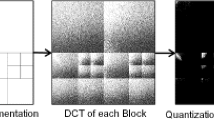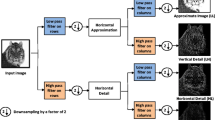Abstract
An increasing number of spatial and frequency domain data hiding techniques have been proposed to address the relatively low embedding capacities of image-based steganography. These techniques have brought promise of higher embedding capacities, albeit at the expense of lower perceptibility. This work proposes a new discrete cosine transform (DCT) approach for color image steganography and implements a global-adaptive-region (GAR) embedding scheme that allows for extremely high embedding capacities while maintaining enhanced perceptibility. The idea is to adapt the variable region size, used to hide the data, in each DCT block of the cover image to the amount of correlation of the image values in the corresponding block. We will demonstrate how this new technique achieves enhanced hiding capacities and perceptibility compared to other spatial, Fourier, and adaptive-region DCT based steganography schemes.








Similar content being viewed by others
Notes
For JPEG standard the block size m×m is 8×8
References
Ahmed N, Natarajan T, Rao K (1974) Discrete cosine transform. IEEE Trans Comput 23(1):90–93
Anderson RJ, Petitcolas FA (1998) On the limits of steganography. IEEE J Sel Areas Commun 16(4):474–481
Bracamonte J, Ansorge M, Pellandini F, Farine PA (2000) Low complexity image matching in the compressed domain by using the dct-phase. In: Proc. of the 6th COST, vol 276, pp 88–93
Bracamonte J, Ansorge M, Pellandini F, Farine PA (2005) Efficient compressed domain target image search and retrieval. In: Image and Video Retrieval, pp 154–163. Springer
Brisbane G, aini RSN, Ogunbona P (2005) High-capacity steganography using a shared colour palette. IEE Proc., Vis. Image Signal Process 152(6):787–792
Castleman K (1996) Digital Image Processing. Prentice Hall, Upper Saddle NJ
Celik MU, Sharma G, Tekalp AM, Saber E (2005) Lossless generalized-lsb data embedding. IEEE Trans Image Process 14(2):253–266
Chan CK, Cheng L (2004) Hiding data in images by simple LSB substitution. Pattern Recogn 37:469–474
Chang CC, Chen TS, Chung LZ (2002) A steganographic method based upon jpeg and quantization table modification. Inform Sci 141:123–138
Chang CC, Chen TS, Chung LZ (2002) A steganographic method based upon jpeg and quantization table modification. Inform Sci 141(1):123–138
Chang CC, Chen YH, Lin CC (2008) A data embedding scheme for color images based on genetic algorithm and absolute moment block truncation coding. Soft Comput 13:21–331
Chang CC, Hsiao JY, Chan CS (2003) Finding optimal least-significant-bit substitution in image hiding by dynamic programming strategy. Pattern Recogn 36 (7):1595–1683
Chang CC, Lin CC, Tseng CS, Tai WL (2007) Reversible hiding in dct-based compressed images. Inform Sci 177:2768–2786
Chang CC, Tai WL, Lin CC (2006) A reversible data hiding scheme based on side match vector quantization. IEEE Trans Circuits Syst Video Technol 16(10):1301–1308
Chen B, Wornell G (2001) Quantization index modulation: A class of provably good methods for digital watermarking and information embedding. IEEE Trans Inf Theory 47(4):1423–1443
Chung KL, Shen CH, Chang LC (2001) A novel svd- and vq-based image hiding scheme. Pattern Recogn Lett 22(9):1051–1058
Curran K, Bailey K (2003) An evaluation of image based steganography methods. Intern J Digital Evidence 2(2):1–40
IEC I (1994) Information technology-digital compression and coding of continuous-tone still images: Requirements and guidelines. Standard, ISO IEC pp. 10, 918–1
Iwata M, Miyake K, Shiozaki A (2004) Digital steganography utilizing features of jpeg images. IEICE Trans Fundam E87-A(4):929–936
Jain A, Uludag U, Hsu R (2002) Hiding a face in a fingerprint image. In: Proc. of the International Conference on Pattern Recognition (ICPR). Quebec City, Canada
Lee Y, Chen L (2000) High capacity image steganographic model. IEE Proc., Vis. Image Signal Process 147(3):288–294
Lin CC, Shiu PF (2009) Dct-based reversible data hiding scheme. In: Proc. of the 3rd International Conference on Ubiquitous Information Management and Communication (ICUIMC09), pp 327–335
Lin CC, Shiu PF (2010) High capacity data hiding scheme for dct-based images. J Inform Hiding Multi Signal Process 1(3):220–240
Lin CY, Chang CC, Wang YZ (2008) Reversible steganographic method with high payload for jpeg images. IEICE Trans. Inf Syst 91-D(3):836–845
Marvel LM, Charles G, Boncelet J, Retter CT (1999) Spread spectrum image steganography. IEEE Trans Image Process 8(8):1075–1083
Nozaki K, Niimi M, Eason RO, Kawaguchi E (1998) A large capacity steganography using color bmp images
Pavlidis G, Tsompanopoulos A, Papamarkos N, Chamzas C (2003) Jpeg2000 over noisy communication channels thorough evaluation and cost analysis. Signal Process Image Commun 18(6):497–514
Petitcolas FA, Anderson RJ, Kuhn MG (1999) Information hiding-A survey. Proc IEEE 87(7):1062–1078
Provos N, Honeyman P (2003) Hide and seek: An introduction to steganography. In: IEEE Security & Privacy Magazine, pp 32–44. IEEE Computer Society
Qazanfari K, Safabakhsh R (2013) High-capacity method for hiding data in the discrete cosine transform domain. J Electron Imaging 22(4):043,009–043,009
Rabie T (2007) Frequency-domain data hiding based on the matryoshka principle. Special Issue on Advances in Video Processing and Security Analysis for Multimedia Communications. Intern J Advanced Media and Commun 1(3):298–312
Rabie T (2012) Digital image steganography: An fft approach. In: 4th International Conference on Networked Digital Technologies (NDT), pp 217–230. Springer Verlag
Rabie T (2013) High-capacity steganography. In: 6th International Congress on Image and Signal Processing (CISP), vol 2, pp 858–863
Rabie T, Kamel I (2015) On the embedding limits of the discrete cosine transform. Multimedia Tools Appl. http://link.springer.com/article/10.1007/s11042-015-2557-x
Rao K, Yip P (1990) Discrete Cosine Transform: Algorithms, Advantages, Applications. Academic Press, ISBN 0-12-580203-X Boston
Rodrigues J, Rios J, Puech W, et al. (2004) Ssb-4 system of steganography using bit 4. In: 5th International Workshop on Image Analysis for Multimedia Interactive Services
Solanki K, Jacobsen N, Madhow U, Manjunath BS, Chandrasekaran S (2004) Robust image-adaptive data hiding using erasure and error correction. IEEE Trans Image Process 13(12):1627–1639
Tian J (2003) Reversible data embedding using a difference expansion. IEEE Trans Circuits Syst Video Technol 13(8):890–896
Tsai P, Hu YC, Chang CC (2002) An image hiding technique using block truncation coding. In: Proc. of Pacific Rim Workshop on Digital Steganography, pp 54–64
Wang X, Yao Z, Li CT (2005) A palette-based image steganographic method using colour quantisation. In: Proc. of the IEEE International Conference on Image Processing (ICIP), pp II – 1090–3
Wu M, Liu B (2003) Data hiding in image and video:part I - fundamental issues and solutions. IEEE Trans Image Process 12(6):685–695
Yang B, Schmucker M, Funk W, Busch C, Sun S (2004) Integer dct-based reversible watermarking for images using companding technique. Proc SPIE 5306, Security, Steganography and Watermarking of Multimedia Contents, vol 6
Acknowledgments
The authors would like to thank the anonymous reviewers for their constructive comments that helped improve the original manuscript. This work was funded by the College of Graduate Studies and Research at the University of Sharjah under research grant number 15020403005-P for 2015.
Author information
Authors and Affiliations
Corresponding author
Rights and permissions
About this article
Cite this article
Rabie, T., Kamel, I. High-capacity steganography: a global-adaptive-region discrete cosine transform approach. Multimed Tools Appl 76, 6473–6493 (2017). https://doi.org/10.1007/s11042-016-3301-x
Received:
Revised:
Accepted:
Published:
Issue Date:
DOI: https://doi.org/10.1007/s11042-016-3301-x




